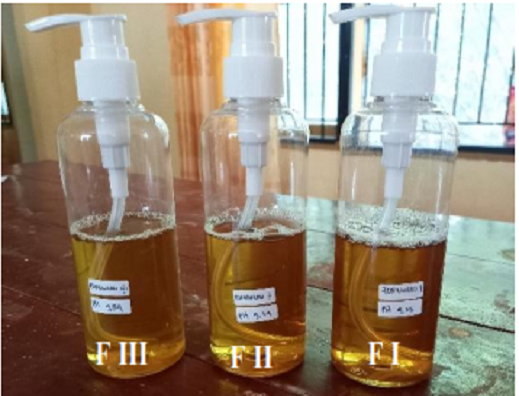Formulation of Lahuna Leave (Eupatorium odoratum) and Sirih Leave Extract (Piper betle L.) as Antiseptic Liquid Soap
Abstract
Infectious diseases caused by microorganisms are the main cause of high morbidity and mortality in the world. One of the plants that have the potential as an antiseptic is a lahuna leaf. Lahuna leaves contain active antibacterial compounds and the addition of betel leaf to the liquid soap formulations can strengthen the activity of the antiseptic produced. The purpose of this research is to test the effectiveness of liquid soap formulations of lahuna leaves and betel leaves as an antiseptic. The methods used include phytochemical screening, physical observation of liquid soap formulations, and antibacterial activity tests using agar diffusion methods. The results of the phytochemical analysis showed that lahuna leaves contain flavonoids, tannins, terpenoids, and alkaloids, while betel leaves contain flavonoids, saponins, tannins, terpenoids, and alkaloids. The liquid soap formulation of lahuna leaves and betel leaves has a clear yellow color, distinctive aroma, liquid form, rough taste, and lots of foam and has very strong inhibition against Staphylococcus aureus which is characterized by clear zones formed for each formulation I (22.4 mm), formulation II (21.8 mm) and formulation III (20.1 mm). These results indicate the potential of liquid soap formulations of lahuna leaves and betel leaves as antiseptic soap.
Downloads

Copyright (c) 2023 Elfira Jumrah, Andi Nur Fitriani Abubakar, Ayu Safitri Agustina, Syahdam Karneng, Herdie Idriawien Gusti

This work is licensed under a Creative Commons Attribution-NonCommercial-NoDerivatives 4.0 International License.
Authors who publish with this journal agree to the following terms:
- Copyright on any article is retained by the author(s).
- The author grants the journal, the right of first publication with the work simultaneously licensed under a Creative Commons Attribution License that allows others to share the work with an acknowledgment of the work’s authorship and initial publication in this journal.
- Authors are able to enter into separate, additional contractual arrangements for the non-exclusive distribution of the journal’s published version of the work (e.g., post it to an institutional repository or publish it in a book), with an acknowledgment of its initial publication in this journal.
- Authors are permitted and encouraged to post their work online (e.g., in institutional repositories or on their website) prior to and during the submission process, as it can lead to productive exchanges, as well as earlier and greater citation of published work.
- The article and any associated published material is distributed under the Creative Commons Attribution-NonCommercial-NoDerivatives 4.0 International License.





_copy1.png)










